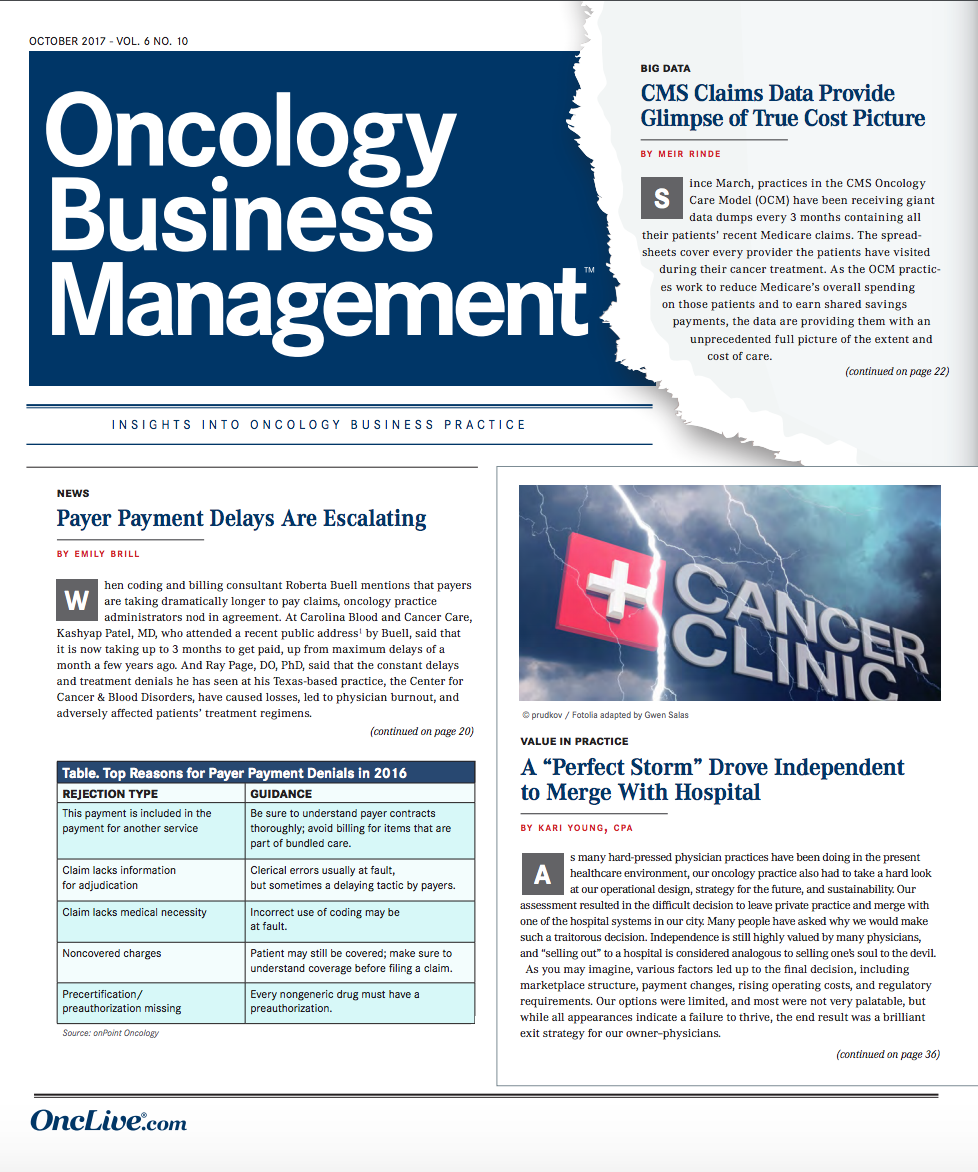Publication
Article
Special Issues
Cota-Watson Effort Aims at Optimal Cost Margins as Well as Improved Care
Author(s):
Investigators at Cota, a New York medical data analytics company, are taking further strides toward putting their growing knowledge of variance in care to work in the clinical setting.
Stuart L. Goldberg, MD, chief medical officer

Stuart L. Goldberg, MD
Investigators at Cota, a New York medical data analytics company, are taking further strides toward putting their growing knowledge of variance in care to work in the clinical setting. This involves both an understanding of which types of treatment get optimal results and knowing which forms of therapy are liable to meet with least resistance from payers, said Stuart L. Goldberg, MD, chief medical officer.
Doctors may not know all the types of care available to them in the context of payer authorizations or payment models, such as accountable care organizations, medical homes, and the like, he said. Cota has teamed up with Watson for Oncology, an IBM artificial intelligence (AI) product, to test a combined system that answers this need for more information at the medical decision level.
Watson provides information on real-world evidence from clinical decisions, and Cota provides a patient classification system that makes sense of that patient information. The pilot study at Hackensack Meridian Health of New Jersey involves 10 oncologists initially who are working with patients with breast cancer. The pilot will be expanded to 500 oncologists by the end of October, according to the plan, and is hoped to improve clinical outcomes as well as payment margins for practices.
“We’re trying to understand, when there is variance in care, what the variance is and why there is variance and figure out which of those [care] strategies is the best one,” Goldberg said. The Watson-Cota system may gain acceptance through the current emphasis on value-based care and a medical landscape in which rising costs of drugs and increasing payer pushback are forcing practices to be more conscious about their treatment choices.
Watson is programmed with clinical evidence and experience from Memorial Sloan Kettering Cancer Center and various other sources of medical information.
One of the goals of the pilot study is to enable physicians at Hackensack Meridian to see the difference between the type of care they have been practicing and the type of care that Watson is recommending, based on its extensive programming. The AI tool should help these physicians to think more broadly about their clinical decisions.
“Watson will advise the physicians on the best academic strategy for taking care of their patients. It’s then going to flip into the Cota system seamlessly and tell the physician, ‘At your institution, this is what you’ve been giving that type of patient. Here are the particular outcomes if you used each of the regimens that Watson has recommended,’” Goldberg said.
After that, the goal is to present the oncologists with an analysis of how successful institutions have been in getting paid for the types of therapies they have chosen. This is important to ensure that the therapy choices they make also make sense for the institutions they work for. “Now I as an oncologist can start to optimize my care, both for quality and for costs,” Goldberg said.
Physicians may not be aware of the narrow range of options different payers may allow, but this information is just as important as knowing which of those options will be effective for a particular patient.
The results from the first phase of the pilot are not yet in, but IBM and Cota are confident about the potential of their joint oncology system and have taken it on the road to market it to other institutions.
“Since it’s, on paper, going well, we think that this is a model that can be introduced at other centers, and so a lot of what our business development people have been doing in recent months is meeting with other centers and showing them the demo,” Goldberg said.
Investigators at Cota, as part of their studies, have done a big-data exercise involving the records for breast cancer treatment of nearly 2000 women. Those efforts have involved breaking down the patient population according to medical billing codes used and, further, by disease classifications—hormone status, lymph node involvement, and tumor size, Goldberg said. That has resulted in a plethora of subtype classifications that can be further analyzed to yield clues to what works and what doesn’t.
“We’ve basically put a bar code on every single patient. We’ve applied that bar code system to a large cohort of patients and sorted them out, and even though there were millions of combinations, even in our first couple of thousand patients, we saw that we were using about 500 of the bar codes.”
Those subtypes indicate more clearly what treatments are optimal and which are impractical, Goldberg said. The top 5 subtypes accounted for more than 20% of the women, so the subtype classifications are statistically well worth studying, Goldberg said, adding that the results from this effort will be presented at a prominent industry meeting early next year.
There has been a lot of variation in care practiced by physicians, according to this analysis, which demonstrates that efficiencies can be achieved through the discovery and use of superior strategies in oncology, Goldberg said.
The use of AI in medicine is promising but can lead to problems if physicians become over-reliant on computing devices, said Alexandre Nossovskoi, an analyst at iGan Partners, a venture capital firm with a focus on tech and digital health companies. Nossovskoi said that when large-scale adoption of automation takes place in any industry, operators may lose essential skills that can help them make successful decisions under high-pressure situations. “Pilots are a good example,” explained Nossovskoi. “Once aircrafts became mostly fly-by-wire, many pilots lost core skills that made them successful under critical situations.”
Another potential problem is the relative inability of AI to think critically. For example, computers are often successful in finding patterns but are not as efficient when identifying context. “This isn’t likely a permanent problem, but pattern finding without sufficient context can lead to misguided decision making,” said Nossovskoi. “In this case,” he added, “the marriage of Watson (which crunches the numbers) with Cota (which gets and offers the data in a structured way) is what’s needed to reduce poor output. The Watson team itself went a long way to get clinical expertise to validate their work, as is needed for the tool to be useful and safe.”
More evidence-based medicine and “better treatment plans driven by actual data instead of gut feel” are perhaps the greatest advantages associated with the Cota and Watson collaboration, Nossovskoi said. “It’s easier for a powerful tool like Watson to do a good job if the data it plays with has been structured, sanitized, and made accessible, as Cota does,” he explained. “For Hackensack,” he added, “the benefit of having an improved standard of care—and less clinician time spent mulling over medical documents—is a no-brainer if it works. If it works here, it’ll work elsewhere, and it will help improve healthcare overall.”
Jonathan Hirsch, founder and president of Syapse, a San Francisco, California, precision medicine software company with a focus on scaling and systematizing precision oncology programs with individualized cancer care, believes AI requires more research to determine its practical use in cancer treatment. “There are fundamental problems around data integration and analytics,” explained Hirsch. He added, “Generally, AI is a really new space.” Hirsch said imaging analysis with AI in the patient’s initial diagnostic and treatment stages “makes a lot of sense.”
Hirsch concluded that ultimately, AI is “going to help with accuracy...and help physicians perform higher-quality work at a higher volume while augmenting some of the efficiency achieved through utilizing EHRs [electronic health records].”









